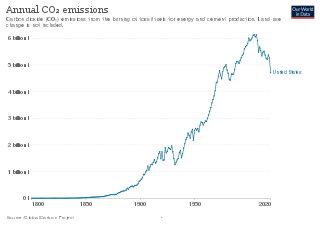ISO 14000 is a family of standards related to environmental management that exists to help organizations (a) minimize how their operations negatively affect the environment ; (b) comply with applicable laws, regulations, and other environmentally oriented requirements; and (c) continually improve in the above.

The Nuclear Regulatory Commission (NRC) is an independent agency of the United States government tasked with protecting public health and safety related to nuclear energy. Established by the Energy Reorganization Act of 1974, the NRC began operations on January 19, 1975, as one of two successor agencies to the United States Atomic Energy Commission. Its functions include overseeing reactor safety and security, administering reactor licensing and renewal, licensing radioactive materials, radionuclide safety, and managing the storage, security, recycling, and disposal of spent fuel.

The National Environmental Policy Act (NEPA) is a United States environmental law that promotes the enhancement of the environment and established the President's Council on Environmental Quality (CEQ). The law was enacted on January 1, 1970. To date, more than 100 nations around the world have enacted national environmental policies modeled after NEPA.
An environmental impact statement (EIS), under United States environmental law, is a document required by the 1969 National Environmental Policy Act (NEPA) for certain actions "significantly affecting the quality of the human environment". An EIS is a tool for decision making. It describes the positive and negative environmental effects of a proposed action, and it usually also lists one or more alternative actions that may be chosen instead of the action described in the EIS. Several U.S. state governments require that a document similar to an EIS be submitted to the state for certain actions. For example, in California, an Environmental Impact Report (EIR) must be submitted to the state for certain actions, as described in the California Environmental Quality Act (CEQA). One of the primary authors of the act is Lynton K. Caldwell.

Life cycle assessment or LCA is a methodology for assessing environmental impacts associated with all the stages of the life cycle of a commercial product, process, or service. For instance, in the case of a manufactured product, environmental impacts are assessed from raw material extraction and processing (cradle), through the product's manufacture, distribution and use, to the recycling or final disposal of the materials composing it (grave).

The Environmental Quality Improvement Act of 1970 is a United States environmental law which was passed to work in conjunction with the National Environmental Policy Act of 1969 (NEPA). One of the two major purposes of the Act was to authorize the creation of an Office of Environmental Quality to provide the professional and administrative staff needed for the Council on Environmental Quality. The second major purpose was to "assure that each Federal department and agency conducting or supporting public works activities which affect the environment shall implement the policies under existing law". To accomplish these purposes, the act gave more responsibilities to the chairman of the Council on Environmental Quality in his new role as director of the Office of Environmental Quality.

The California Environmental Quality Act (CEQA) is a California statute passed in 1970 and signed in to law by then-Governor Ronald Reagan, shortly after the United States federal government passed the National Environmental Policy Act (NEPA), to institute a statewide policy of environmental protection. CEQA does not directly regulate land uses, but instead requires state and local agencies within California to follow a protocol of analysis and public disclosure of environmental impacts of proposed projects and, in a departure from NEPA, adopt all feasible measures to mitigate those impacts. CEQA makes environmental protection a mandatory part of every California state and local (public) agency's decision making process. It has also become the basis for numerous lawsuits concerning public and private projects.

Environmental Impact assessment (EIA) is the assessment of the environmental consequences of a plan, policy, program, or actual projects prior to the decision to move forward with the proposed action. In this context, the term "environmental impact assessment" (EIA) is usually used when applied to actual projects by individuals or companies and the term "strategic environmental assessment" (SEA) applies to policies, plans and programmes most often proposed by organs of state. It is a tool of environmental management forming a part of project approval and decision-making. Environmental assessments may be governed by rules of administrative procedure regarding public participation and documentation of decision making, and may be subject to judicial review.

Environmental policy is the commitment of an organization or government to the laws, regulations, and other policy mechanisms concerning environmental issues. These issues generally include air and water pollution, waste management, ecosystem management, maintenance of biodiversity, the management of natural resources, wildlife and endangered species. For example, concerning environmental policy, the implementation of an eco-energy-oriented policy at a global level to address the issues of global warming and climate changes could be addressed. Policies concerning energy or regulation of toxic substances including pesticides and many types of industrial waste are part of the topic of environmental policy. This policy can be deliberately taken to influence human activities and thereby prevent undesirable effects on the biophysical environment and natural resources, as well as to make sure that changes in the environment do not have unacceptable effects on humans.

Environmental planning is the process of facilitating decision making to carry out land development with the consideration given to the natural environment, social, political, economic and governance factors and provides a holistic framework to achieve sustainable outcomes. A major goal of environmental planning is to create sustainable communities, which aim to conserve and protect undeveloped land.
An environmental management system (EMS) is "a system and database which integrates procedures and processes for training of personnel, monitoring, summarizing, and reporting of specialized environmental performance information to internal and external stakeholders of a firm".
Carbon accounting or greenhouse gas accounting refers to processes used to measure how much carbon dioxide equivalents an organization emits. It is used by states, corporations, and individuals to create the carbon credit commodity traded on carbon markets. Examples of products based on forms of carbon accounting may be found in national inventories, corporate environmental reports, and carbon footprint calculators.

The Leopold matrix is a qualitative environmental impact assessment method developed in 1971 by Luna Leopold and collaborators for the USGS. It is used to identify and assign numerical weightings to potential environmental impacts of proposed projects on the environment. It came as a response to the National Environmental Policy Act of 1969 which was criticized for lacking adequate guidance for government agencies on how to properly predict potential environmental impacts and consequently prepare impact reports.

The environmental policy of the United States is a federal governmental action to regulate activities that have an environmental impact in the United States. The goal of environmental policy is to protect the environment for future generations while interfering as little as possible with the efficiency of commerce or the liberty of the people and to limit inequity in who is burdened with environmental costs. As his first official act bringing in the 1970s, President Richard Nixon signed the U.S. National Environmental Policy Act (NEPA) into law on New Years Day, 1970. Also in the same year, America began celebrating Earth Day, which has been called "the big bang of U.S. environmental politics, launching the country on a sweeping social learning curve about ecological management never before experienced or attempted in any other nation." NEPA established a comprehensive US national environmental policy and created the requirement to prepare an environmental impact statement for “major federal actions significantly affecting the quality of the environment.” Author and consultant Charles H. Eccleston has called NEPA, the world's “environmental Magna Carta”.
Metropolitan Edison Co. v. People Against Nuclear Energy, 460 U.S. 766 (1983), was a case decided by the United States Supreme Court.
Baltimore Gas & Electric Co. v. Natural Resources Defense Council, Inc., 462 U.S. 87 (1983), is a United States Supreme Court decision that held valid a Nuclear Regulatory Commission (NRC) rule that during the licensing of nuclear power plants, the permanent storage of nuclear waste should be assumed to have no environmental impact.
ISO 50001Energy management systems - Requirements with guidance for use, is an international standard created by the International Organization for Standardization (ISO). The standard specifies the requirements for establishing, implementing, maintaining and improving an energy management system, whose purpose is to enable an organization to follow a systematic approach in achieving continual improvement of energy performance, including energy efficiency, energy security, energy use and consumption.

The Responsibly And Professionally Invigorating Development Act of 2013 is a bill that would aim to expedite the review process required by the National Environmental Policy Act (NEPA) for construction projects that are partly or fully financed with federal funds or require permits or approvals from federal regulatory agencies. It was to do so by establishing specific deadlines for environmental reviews, which sometimes go on so long that they can delay a project for years.
The International Association for Impact Assessment (IAIA) is an international association of professionals involved with impact assessment, including both social impact assessment and environmental impact assessment.
Cumulative effects, also referred to as cumulative environmental effects and cumulative impacts, can be defined as changes to the environment caused by the combined impact of past, present and future human activities and natural processes. Cumulative effects to the environment are the result of multiple activities whose individual direct impacts may be relatively minor but in combination with others result are significant environmental effects. The multiple impacts of different activities may have an additive, synergistic or antagonistic effect on one another and with natural processes. Cumulative effects can be difficult to predict and manage due to inadequate environmental baseline data, complex ecological processes, and the large scale at which human development occurs.








